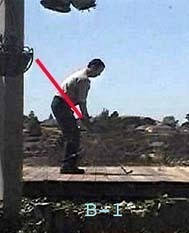I have heard that Hogan had his irons bent 6 to 8 degrees flat off standard which would make sense since he was not a tall guy. If someone really wanted to know for sure, you could just measure the angle off an old film clip if you knew what club he was hitting. A nice “straight from behind” shot of an iron from the fairway would be good if you could catch it at impact. You would then take off 1/2 a degree for the flattening of the lie due to shaft flex (bowing down) and that would get you pretty close to what Hogan had his irons set at.
It’s true you won’t find much variation between the really good ball strikers at impact… slight forward lean of the shaft and a flat left wrist.
But even at the pro level, there are differences too. The guys that strike it the best do bring into impact a shaft that is more pre stressed
and do hold the flex of the shaft longer than other players.
As far as a loop goes, I like the one you described above, steeper to flatter on the way down, because you have to get the shaft back down to your impact plane (elbow plane). I have seen a lot of great players with this type of action. A loop allows the good player to keep their hands in constant motion from start to finish, and this is also beneficial for the rhythm and feel of the swing. I can’t see why it would be advantageous to actually stop the hands completely, then change direction and hit the ball. It’s a good drill to educate the hands, but not advisable to interfere with the fluidity of a good players swing.
One of my good friends who was a fine tour player and won many events around the world is now teaching full time, and he tries to instruct his students to hook the ball first as I do. If he can get them to move the club inside out and on a flat plane, he says he then has something to work with. From there he can work with their aiming point, low point, and type of release action to convert the hook into a powerful motion that hits it straight fairly easily. The OTT cutting motion that most amateurs apply is a dead end road. There is only so far you can go before you have to do the full swing overhaul.
As far as drills go… swinging back along the outside of a bench has some logic for the backswing but not the down swing.
I would not be as big a fan of flashlight drills as some… because the hands can do a lot of manipulating with arms in the wrong places.
I really have yet to find a perfect swing plane drill that completely sets up the player for a flawless motion. It’s just not that simple in the full swing. Because of the fact that we don’t swing on an “eye plane” where the club would appear to move back and forth in a straight line, we are bombarded with endless optical illusions because we are looking down on the plane from above it. We see two different arcs (takeaway, and delivery) the plane shifts in a way that we can’t just build a plane out of plywood in the garage and swing on it. It won’t work for any swing past the 1rst parallel.
First you must choose between hitting and swinging.
Then you must get the body and torso to move the correct way to match that protocol.
Second you have to train the arms the correct movements to match that chosen torso rotation.
Thirdly you then train and educate the hands to move the shaft on plane based upon the motion of the body, torso, and arm action.
I don’t think there is a substitute for the watchful eye of a qualified instructor. Video is very helpful too. It won’t lie to you.
Before I would make a suggestion as to the ideal swing plane for a player, I would asses their body type, height and flexibility. I would then determine their proper impact fix for their body and size. Then we would go bend all their clubs. Then I would asses their forearm strength and potential for torso rotational speed, and left knee, left hip action. Then I would focus on their backswing length based upon whether or not they are hitting or swinging, and how flexible their torso can rotate, and the amount of extensor action they are comfortable applying. Finally I would have to look at the torso flexibility at the finish and the overall range of motion between the torso and the hips. Once all this is accounted for, then a swing plane prescription can be written.
I just don’t think there is a one plane for everyone protocol, or any universal drills that would be the same for everyone either regarding the backswing.
This swing plane concept, to really get it right, to maximize the full long term potential of any given player is really tough stuff. Not impossible by any means though.
